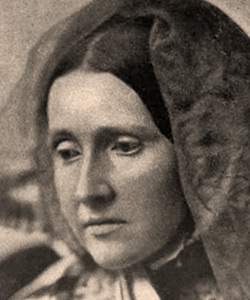Julia Ward Howe (American National Biography)
Scholarship
By far Howe's most famous work, the "Battle Hymn of the Republic," was published in the Atlantic Monthly in February 1862. She wrote the poem in 1861 while in Washington, D.C., with her husband, who was helping distribute supplies to Massachusetts regiments. Set to the music of "John Brown's Body," her poem became the rallying song for the North during the final year of the Civil War.
The "Battle Hymn" also brought Howe the fame required to more actively pursue a writing career. In 1867 she produced eleven issues of a literary magazine, Northern Lights. That same year she wrote about her European travels in From the Oak to the Olive (1868). In 1870 she founded the weekly Woman's Journal, a successful, widely-read suffragist magazine to which she contributed for twenty years. She edited a defense of coeducation titled Sex and Education in 1874 and brought out a collection of her own addresses, Modern Society, in 1880. She published a biography of Margaret Fuller in 1883, and another collection of lectures, Is Polite Society Polite?, in 1895. Her popular memoirs, Reminiscences, appeared in 1899. Indeed, Howe continued to write lectures, poems, and articles until her death.
The "Battle Hymn" also brought Howe the fame required to more actively pursue a writing career. In 1867 she produced eleven issues of a literary magazine, Northern Lights. That same year she wrote about her European travels in From the Oak to the Olive (1868). In 1870 she founded the weekly Woman's Journal, a successful, widely-read suffragist magazine to which she contributed for twenty years. She edited a defense of coeducation titled Sex and Education in 1874 and brought out a collection of her own addresses, Modern Society, in 1880. She published a biography of Margaret Fuller in 1883, and another collection of lectures, Is Polite Society Polite?, in 1895. Her popular memoirs, Reminiscences, appeared in 1899. Indeed, Howe continued to write lectures, poems, and articles until her death.
Sandra F. VanBurkleo and Mary Jo Miles, "Howe, Julia Ward," American National Biography Online, February 2000, http://www.anb.org/articles/15/15-00348.html.







